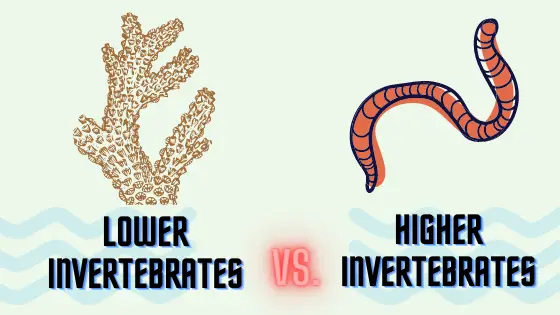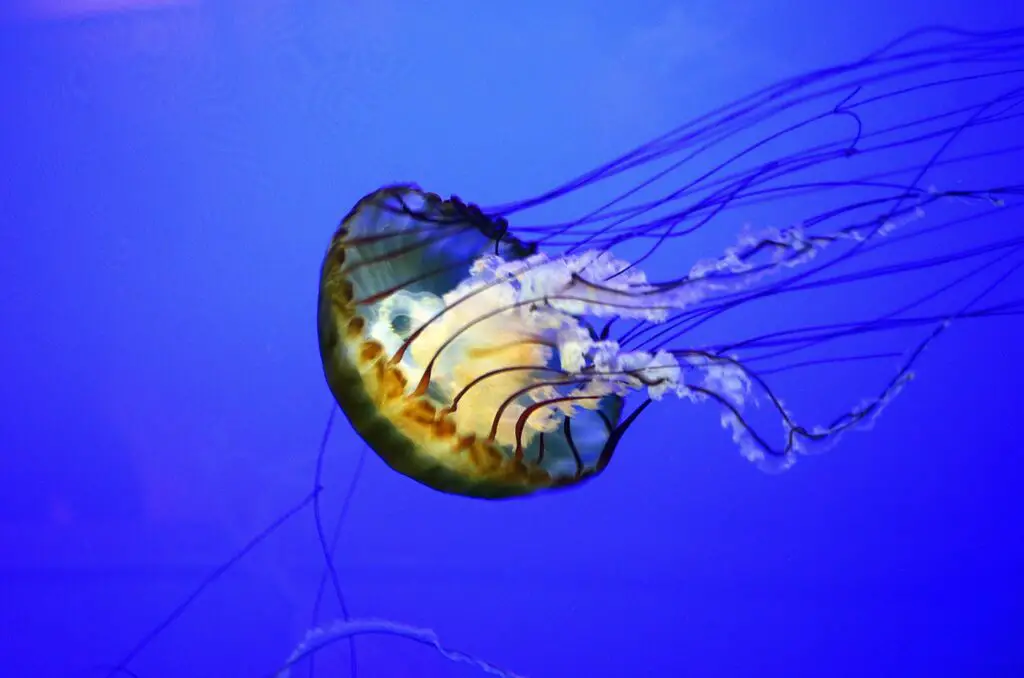Difference Between Lower And Higher Invertebrates
In this post, we will know about the key differences between Lower Invertebrates and Higher Invertebrates
After reading this post, you can perfectly differentiate a lower invertebrate from a higher invertebrate and vice-versa.
We all know that invertebrates are those organisms that has no vertebral column in their body so, they are also known as non-chordates.
Almost 98% of the total animal species are invertebrates which constitute roughly about 1.2 million species discovered so far. Meaning that the invertebrates have the highest population than the vertebrates.
The invertebrate phyla are usually referred to as Lower and Higher Invertebrates.
The higher invertebrates include the majority of the invertebrates almost 1 million out of 1.2 million invertebrate species.
The lower invertebrates are generally smaller in size and very simple in body organization. According to the main context of evolution, it is believed that they have originated near the base of the phylogenetic tree of the Animal Kingdom.
On the other hand, the higher invertebrates are generally larger in size and a bit complex in body organization. They take up higher positions in the phylogenetic tree of the Animal Kingdom.

Comparison Chart: Lower Invertebrates Vs. Higher Invertebrates
| DIFFERENCE BASED UPON PROPERTIES | LOWER INVERTEBRATES | HIGHER INVERTEBRATES |
|---|---|---|
| BODY | The body is of a very simple type with not much metabolic functioning | The body is of a sightly complex type with more metabolic functioning |
| INCLUDES PHYLA | Phyla Porifera, Cnidaria, Ctenophora, Platyhelminthes, and Aschelminthes | Phyla Annelida, Arthropoda, Mollusca, and Echinodermata |
| SIZE & SHAPE | Generally smaller and very simple in size and shape | Generally larger and very extraordinary in size and shape |
| NUMERICAL STRENGTH | Includes very fewer species than the higher invertebrates | Includes the majority of the invertebrates |
| Include only 0.2 million out of 1.2 million invertebrates | Include 1 million out of 1.2 million invertebrates | |
| SYMMETRY | Organisms are Radially Symmetrical, or Bilaterally Symmetrical, or Asymmetrical in nature | Organisms are Bilaterally Symmetrical |
| EMBRYONIC LAYERS | Germ layers wanting or 2 or 3 germ layers | Three germ layers present |
| SEGMENTATION | No segmentation of the body | The body is well segmented into three or more parts |
| MOUTH AND ANUS | Generally, no separate mouth and anus | Mouth and Anus are well separated and of distinct type |
| VASCULAR SYSTEM | The vascular system is usually maintained by the layers of the skin and body parts | They have a separate and well distinct type of vascular system |
| Blood Vascular system is not well-developed and in many it’s absent | A well-developed blood vascular system is present | |
| GUT | No proper muscular gut is present | A proper and true muscular gut is present and it’s well developed |
| COELOM | No coelom present. While some are Acoelomates and Pseudocoelomates | All have a true coelom and so are true coelomates |
| NOTOCHORD | Notochord is absent | Notochord is absent |
| LEVEL OF ORGANIZATION | Cellular, Tissue, or Organ Level of Body Organization | All have Organ-System Level of Body Organization |
| REPRODUCTION | Both Sexually and Asexually. Asexual Reproduction is more common. | Both Sexually and Asexually. Sexual Reproduction is more common. |
| EXOSKELETON | No hard exoskeleton present | Generally, a hard exoskeleton is present to protect and support the body |
| ENDOSKELETON | No endoskeleton present | A selected few higher invertebrates have endoskeletons, which includes squid and octopus, as well as echinoderms such as starfish and sea urchins. |
| WAY OF LIVING | Mostly Free-living, Aquatic (mostly marine), Parasitic, and quite a many are Sessile as well | Aquatic (both marine and freshwater), Terrestrial, Parasitic (mostly in plants), and a very few are Free-living |
| PHYLOGENY | They originated in the main lines of evolution, near the base of the phylogenetic tree of the Animal kingdom | They occupy a higher position in the phylogenetic tree of the Animal kingdom |

Definition of Lower Invertebrates
Lower Invertebrates are the lower group of invertebrates that includes very simple organisms which have the cellular level to simple organ level of body organization.
These are really very simple organisms with radial or bilateral or no symmetry at all.
Lower Invertebrates include both asymmetrical and symmetrical organisms. They include organisms belonging to 5 phyla Porifera, Cnidaria, Ctenophora, Platyhelminthes, and Aschelminthes.
Phylum Porifera: These are commonly known as Sponges. These are generally marine and mostly asymmetrical animals. These are primitive multicellular animals having cellular level of body organization. Example: Leucosolenia, Scypha, etc.
Phylum Cnidaria: These are aquatic, marine, sessile, or free-living animals. They are radially symmetrical and contain tissue level of body organization. They have nematocytes present on the tentacles of the body. Example: Aurelia, Gorgonia, etc.
Phylum Ctenophora: These are exclusively marine animals and are commonly called sea walnuts or comb jellies. These are radially symmetrical and diploblastic organisms with tissue level of body organization. The presence of comb plates is a characteristic feature. Example: Pleurobranchia, Ctenoplana, etc.
Phylum Platyhelminthes: These are also called flatworms and are mostly endoparasites living inside animals including humans. These are bilaterally symmetrical, triploblastic, and acoelomate animals with organ level of body organization. Specialized flame cells are present in the body. Example: Liver fluke, Tapeworm, etc.
Phylum Aschelminthes: These are also called roundworms and are generally free-living, aquatic, terrestrial, or parasitic in nature. These are bilaterally symmetrical, triploblastic, and pseudocoelomate animals with organ level of body organization. Example: Hookworm, Ascaris, etc.

Definition of Higher Invertebrates
Higher Invertebrates are the higher group of invertebrates that includes very simple organisms where all have simple organ-system level of body organization.
Their body organization is far more complex than those of the lower invertebrates. These are a bit complex organisms with all of the species having bilateral symmetry.
They are all larger in size with more metabolic functioning of the body. These occupy a higher position in the phylogenetic tree of Animal kingdom.
Higher Invertebrates include organisms belonging to 4 phyla Annelida, Arthropoda, Mollusca, and Echinodermata.
Phylum Annelida: These include organisms that are aquatic (marine and freshwater) or terrestrial, free-living, and sometimes parasitic organisms. They are bilaterally symmetrical, triploblastic, metamerically segmented, and coelomate animals having organ-system level of body organization. Example: Earthworm, Blood-sucking leech, etc.
Phylum Arthropoda: These include all insects and it is the largest phylum of the Animal Kingdom. They are all bilaterally symmetrical, triploblastic, segmented (head, thorax, and abdomen), and coelomate animals having organ-system level of body organization. Example: Locust, Crabs, Cockroach, etc.
Phylum Mollusca: This is the second largest animal phylum. They are terrestrial or aquatic (marine or freshwater) having organ-system level of body organization. They are all bilaterally symmetrical, triploblastic, and coelomate animals. There body is covered by a calcareous shell and is unsegmented with a distinct head, muscular foot, and visceral hump. Example: Snails, Pearl Oyester, Octopus, etc
Phylum Echinodermata: These are all marine with organ-system level of body organization. They are triploblastic and coelomate animals with proper organ-system level of body organization. The adults are radially symmetrical while the larvae are bilaterally symmetrical. Example: Starfish, Sea Cucumber, Sea Urchin, Sea Lily, etc.
Key Differences Between Lower And Higher Invertebrates
1. Lower Invertebrates have a simple multi-cellular, tissue, and organ level of body organization. Whereas, Higher Invertebrates have more complex organ-system level of body organization.
2. Lower Invertebrates are located near the base of the phylogenetic tree. Whereas, Higher Invertebrates are located up at a higher position in the phylogenetic tree.
3. Lower Invertebrates show more phylogenetic relationships with their ancestors. Whereas, Higher Invertebrates shows only a few phylogenetic relationships with their ancestors.
4. Lower Invertebrates can be seen in many of the untouched and harsh habitats. Whereas, Higher Invertebrates are more likely available in the normal habitats.
5. A majority of the lower invertebrates seem like non-living organisms because of their simple body organization and way of living. Whereas, the higher invertebrates look living and more different with extraordinary structures in their body.
Conclusion
Although, lower invertebrates are a bit different from the higher invertebrates but, both are invertebrates in common.
And, they both are considered the most ecologically and economically important organisms of the planet earth.
Without them, the ecosystem and environment of both the aquatic and terrestrial life will alter and can become void as they help in maintaining and in the smooth running of the various biological cycles and also the food web and the food chain too.
